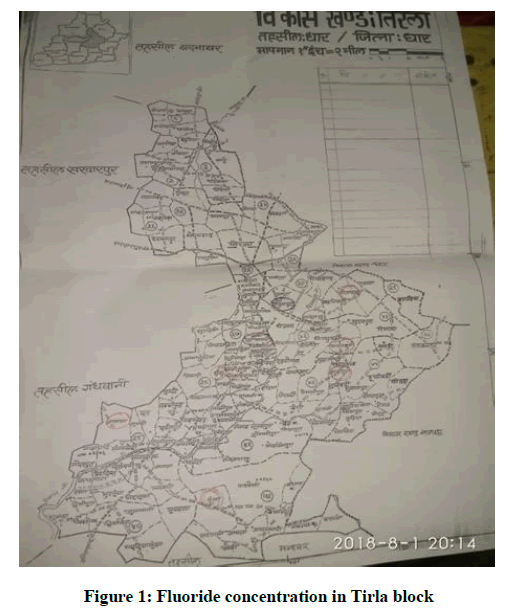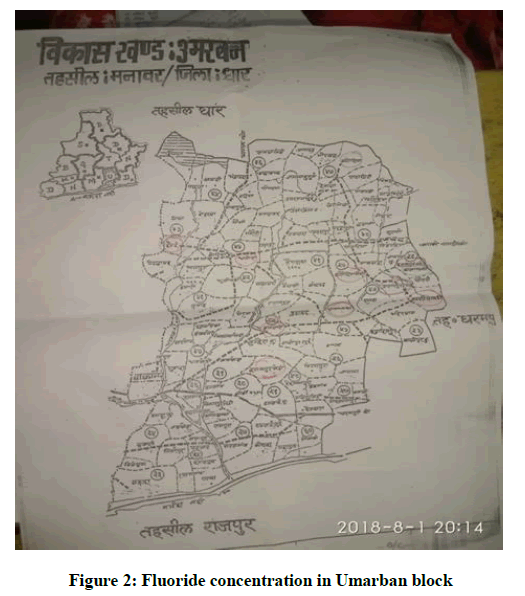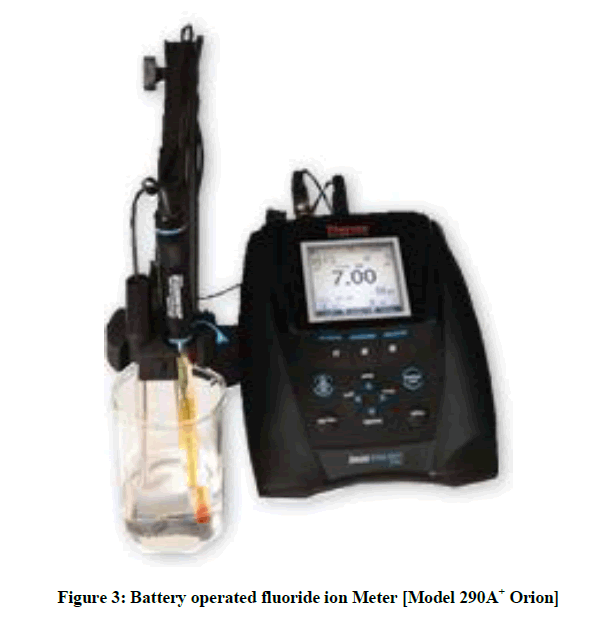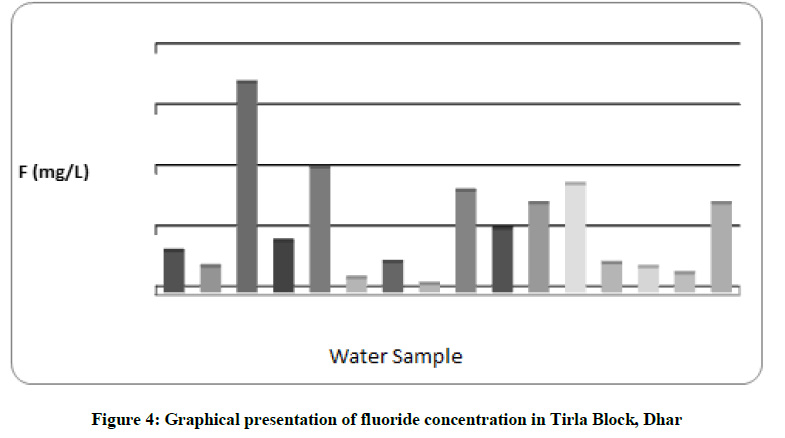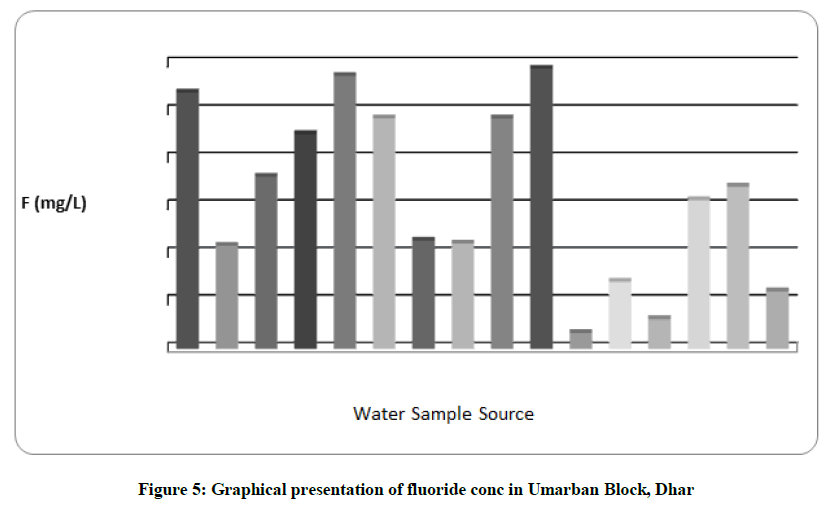Research Article - Der Pharma Chemica ( 2018) Volume 10, Issue 11
Fluoride Content Studies in Underground Water of Umarban and Tirla Blocks (Dhar) of Madhya Pradesh, India
Navin Rathore1*, BirjeshSingh1 and Pradeep Paliwal2
1RabindraNath Tagore University, Bhopal, Madhya Pradesh, India
2Nirmala College, Ujjain, Madhya Pradesh, India
Abstract
Water is one of the major components of life for living being on earth. On the earth, it is abundant and most unusual natural component. Hand pumps, wells, ponds and rivers are the common resources for villages of Dhar district, a tribal belt area. Among them water quality of hand pump is degrading continuously with faster rate and therefore it is essential to monitor water quality time to time and treatment, if needed before use of drinking purpose. The present manuscript deals with fluoride concentration at Umarban and Tirla blocks of Dhar district of Madhya Pradesh. Various drinking water sources of Umarban and Tirla blocks of Dhar district were specified and selected for sampling and their fluoride concentration were analyzed. The fluoride concentration in Khandan Bujurg (S-3), Ghanora (S-26) and Kuwa (S-21) water sources, is much higher than Badlipura (S-8), Dhanora (S-27) and Banzari (S-29) etc. These water sources having high fluoride concentration are marked as red. It is advised that water from these water sources must not to be used for drinking purpose before treatment.
Keywords
Fluoride concentration, Water quality analysis, Tribal belt, Dhar district.
Introduction
Water is the most important and essential natural resource for life on earth. It is freely available and most abundantly available in nature. Although ground water contribution is only 0.6% of the total water resources on earth, and it is also the major source of drinking water for rural and urban population as well. In India, about 20 states have been identified with problems of high fluoride in ground water resources and rural population who are mainly depended on underground water for drinking purposes and badly affected by fluoride contaminations [1-9].
Tribal and rarely approachable area of Madhya Pradesh is still away from the development in various fields like transport, education, sanitary, water supply, health etc. than other part of country. Most of the government schemes are not reachable in these remote area and if some approachable than not being properly utilized by these people. Literacy is major factor which play crucial role in development. In some villages of MP, the dental fluorosis is spreading within the population a silent epidemic. Dhar is a district of southern Madhya Pradesh where about 82% of the population belongs to the Scheduled Tribes. The ground water level in Umarban and Tirla blocks area is too low and available with high fluoride concentration. As per the reports of public health and engineering department [PHED], 1683 sources of drinking water of 3763 tested sources in 324 villages are contaminated because Malwa hills are formed of fractured basaltic rocks containing fluoride in combined form with either aluminum or with calcium. The Narmada alluvial valley is comprised of sandy silt with variable amount of calcium and aluminum bound with some amount of fluoride [10].
In last few years, urbanization, industrialization and much utilization of water resources have attended to the degradation of water quality and reduction in per capita availability in several countries under development and developing countries as well. Due to various ecological factors either natural or manmade, the ground water is getting polluted because of disposal of hazardous wastes, liquid and solid wastes from industries, sewage disposal, surface impoundments etc. During its complex flow history, groundwater passes through various geological formations leading to consequent contamination in shallow aquifers. Presence of various contaminants like fluoride, arsenic, nitrate, sulfate, pesticides, other heavy metals etc. in underground water has been reported from different parts of India [11-14].
In Indian, fluoride is the major inorganic pollutant of natural origin found in ground water. It is well reported that higher concentration of fluoride that its limit is a matter of serious concern regarding public health. Various technologies are being used to remove fluoride from water but still the problem is showing its impact in various states of India. The occurrence of fluoride in groundwater is due to weathering and leaching of fluoride-bearing minerals from rocks and sediments. Low fluoride concentration is beneficial for but high concentration may cause dental fluorosis and skeletal fluorosis [15-18].
Such fluoride problem is reported in several research paper and articles have been published in Dhar district of MP. Hence, ground water sources of Umarban and Tirla blocks have been chosen for present study.
Study Area
Dhar district is surrounded to the north Khargone, to northeast Barwani, to the southestAlirajpur and Jhabua to the west. Dhar has subtropical climate and average rainfall is 45 mm. In groundwater low calcium and high carbonate alkalinity effects high fluoride content (Figures 1 and 2).
Materials and Methods
In present study was carried out in 16 villages of Dhar district of Madhya Pradesh. The study areas were situated in Tirla and Umarban blocks. Hand pumps and tube wells are the major sources of drinking water supply because there is no perennial river nearby area selected for present study. Target villages were selected for the present study on the basis of data gathered from health survey of school children that had severe dental fluorosis. It was decided to carry out water quality monitoring for 32 selected water sources of 16 villages of Tirla and Umarban blocks including open wells, hand pumps and bore wells.
Sample collection and analysis
All the 16 villages shortlisted are located in two distinct blocks i.e. Tirla and Umarban. Samples were collected in polyethylene bottles, which were washed with detergents and rinsed with double distilled water prior to sample collection. These washed and dried bottles were also rinsed 2-3 times with water sample before collecting water sample and stored at 40°C until used for analysis. Battery operated fluoride ion Meter [Model 290A+ Orion] (Figure 3) was used to study fluoride concentration in water samples according to APHA prescribed standard method [19,20].
Results and Discussion
In the present study fluoride concentration at Tirla block is ranging between 0.59 to 17.2 mg/l (Table 1 and Figure 4) and in Umarban block is ranging between 0.67 to 11.8 mg/l (Table 2 and Figure 5). In the Tirla and Umarban blocks, Hand Pumps are the main source of drinking water. In the present study it was found that in Tirla block S-3 is highly fluoride affected area where the concentration is found to be 17.2 mg/l and S-8 is low concentration of fluoride is 0.59 mg/l and S-26 is high concentration of fluoride i.e. 11.8 mg/l and S-27 is low concentration of fluoride 0.67 mg/l [21].
| S. No. | Sampling Station | Source | Fluoride Concentration (mg/l) |
|---|---|---|---|
| 1 | S1 | HP | 3.31 |
| 2 | S2 | TW | 2.04 |
| 3 | S3 | HP | 17.2 |
| 4 | S4 | HP | 4.16 |
| 5 | S5 | HP | 10.2 |
| 6 | S6 | HP | 1.1 |
| 7 | S7 | HP | 2.41 |
| 8 | S8 | HP | 0.59 |
| 9 | S9 | HP | 8.3 |
| 10 | S10 | HP | 5.14 |
| 11 | S11 | HP | 7.24 |
| 12 | S12 | HP | 8.84 |
| 13 | S13 | TW | 2.31 |
| 14 | S14 | HP | 1.98 |
| 15 | S15 | HP | 1.48 |
| 16 | S16 | HP | 7.24 |
HP-Hand Pump, TW-Tube Well, [S1]-Phoolchand house BhutiyaBawadi, [S2]- Nera Vat tree BhutiyaBawadi, [S3]-SarayTalai KhandanBujurg, [S4]-In front of Anganwadi KhandanBujurg, [S5]-Near school KhandanKhurd, [S6]-Mal Singh’s house KhandanKhurd, [S7]-Mata mandir Badlipura, [S8]-Samudayik Bhawan Badlipura, [S9]-Near Munnalal’s house Sitapat, [S10]-Near new school Sitapat, [S11]-Panchayat Bhawan Kuwa, [S12]- Anganwadi Kuwa, [S13]-Above Ghati Amla, [S13]-Panchayat Bhawan Amla, [S15]-Anganwadi Mohanpura, [S16]-Primary School Mohanpura 2
Table 1: Fluoride test of groundwater of villages of Tirla block
| S. No. | Sampling Station | Source | Fluoride concentration in mg/l |
|---|---|---|---|
| 1 | S17 | HP | 10.8 |
| 2 | S18 | HP | 4.35 |
| 3 | S19 | HP | 7.26 |
| 4 | S20 | TW | 9.06 |
| 5 | S21 | HP | 11.5 |
| 6 | S22 | HP | 9.71 |
| 7 | S23 | HP | 4.57 |
| 8 | S24 | HP | 4.45 |
| 9 | S25 | HP | 9.72 |
| 10 | S26 | HP | 11.8 |
| 11 | S27 | HP | 0.67 |
| 12 | S28 | HP | 2.83 |
| 13 | S29 | HP | 1.26 |
| 14 | S30 | HP | 6.27 |
| 15 | S31 | TW | 6.84 |
| 16 | S32 | HP | 2.43 |
HP-Hand Pump, TW-Tube Well, [S17]- Near hospital, Pratapura; [S18]-Chouk wala Pratapura; [S19]- Ramesh’s house KarondiyaMota; [S20]-Shera’s house KarondiyaMota; [S21]- Ganesh’ house Hasanpur; [S22]-Road side Hasanpur; [S23]-Panchayat bhawan Dasai; [S24]-Near Makhan’s house Dasai; [S25]-Ramesh’s house Ramadhama; [S26]-Near Talav Ramadhama [S27]-Aanganwadi Dhamara; [S28]-Gendalal’s house Dhamara; [S29]- Saleem’s farm Banjari ; [30]- Near Neem tree Banjari ; [S31]- Dangi mohalla Kalabawadi ; [S32]- Near Gabru’s house Kalabawadi
Table 2: Fluoride test of Groundwater of villages of Umarban Block
Conclusion
Fluoride concentration near the residence of Sarayat Bai Khandan Bujurg village area of Tirla block has been found 17.2 mg/l while at Talav area of Umarban block has been found 11.8 mg/l has higher concentration of fluoride than total samples taken for study from Hand pumps and Tubewells. Out of total 32 sources studied, some red point sources are found to be in very dangerous state of fluoride concentration. Number of several dental fluorosis cases has been observed during sample collection in the villages and dependency on Hand pumps might be the cause as per reports.
Acknowledgement
Authors acknowledged to HOD, Department of Chemistry, Ravindranath Tagore University, Dr. MD Bharti, Dhar for providing necessary lab facilities and suggestions during this study.
References
- Y.M. Shivarajashankara, A.R. Shivashankara, S.H. Rao, P.G. Bhar, Fluoride, 2001, 34, 103.
- Q. Xiang, Y. Liang, L. Chen, C. Wang, B. Chen, X. Chen, M. Zhou, Fluoride, 2003, 36, 84.
- B. Seraj, M. Shahrabi, M. Falahzade, F. Falahzade, N. Akhondi, J. Dent. Tehran Univ. Med. Sci., 2006, 19, 80.
- R. Srikanth, A. Gautam, S.C. Jaiswal, S. Pavitra, Environ. Monit. Assess., 2013, 185(3), 2343.
- J.P. Yadav, S. Lata, S.K. Kataria, S. Kumar, Environ Geochem Health, Environ. Geochem. Health, 2009, 31(4), 431.
- S. Ayoob, S, and A.K. Gupta, Critical Reviews in Environ. Sci. Tech., 2006, 36, 433.
- J. Hussain and K.C. Sharma, Environ. Monit. Assess., 2010, 162, 14.
- B. Haribabu, P. Suresh, A. Ramesh Babu, K. SwarnaLatha, A.V.V. Swamy, Rasayana J. Chem., 2016, 9(2), 222.
- S. Aparna, G. Ragini, Int. J. Adv. Sci. Tech. Res., 2017, 2(7), 228.
- K. Manoj, P. Avinash, Ind. J. Occup. Environ. Med., 2012, 16(1), 40.
- R.N. Khandekar, U.C. Mishra, Sci. Total Environ., 1984, 40, 269.
- P. Manisha, Rambabu, M. Ankita, Int. J. ChemTech Res., 2013, 5(5), 2593.
- B.S. Bhagel, D.K. Aske, J. Saikhediya, A. Thakur, IRJC, 2014, 5, 8.
- S. Ray, J. Sainkhediya, Ind. J. Plant Sci., 2012, 1, 144.
- B.S. Rayappanla, Jeyaprabha, P. Prakash, World J. Pharmacy Pharmaceutical Sci., 2014, 3(6), 1899.
- P.D. Sreedevi, S. Ahmed, J. Applicable Chem., 2013, 2(3), 526.
- K. Ravindra, V.K. Garg, Int. J. Environ. Health Res., 2005, 2, 1.
- APHA Standard Method for the Examination of Water and Wastewater, 17th edition, American Public Health Association, Washington DC, 2002.
- APHA Standard Methods for the Examination of Water and Waste Water, 21th (Edn.), American Public Health Association, Washington DC, 2005.
- Water Aid, PSI people Science Institute, DehraDoon, 2008.
- S. Umesh, S. Swati, IJES, 2014, 5(1), 144.

